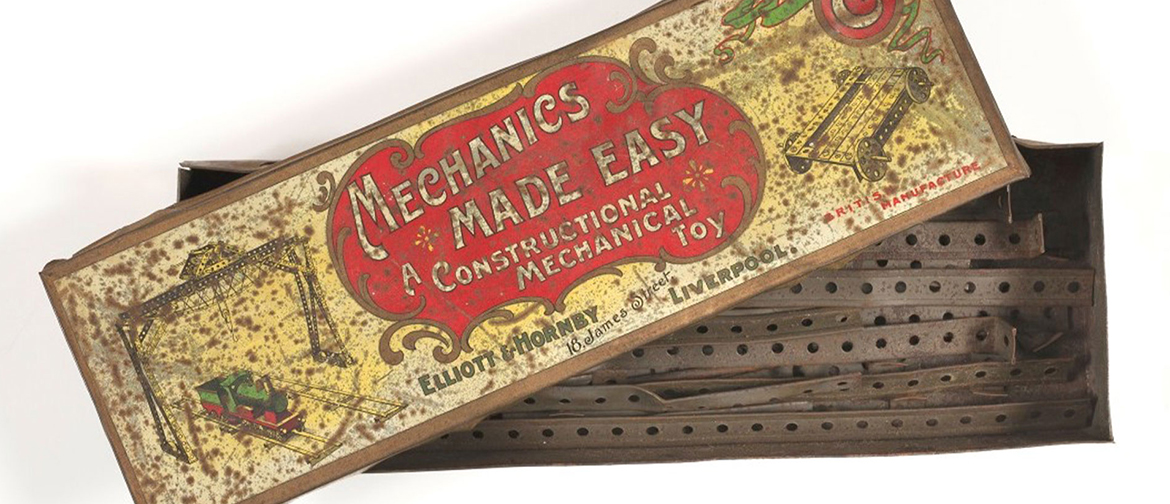A SELF-MADE MAN
Frank Hornby’s life history, as he told it in Meccano Magazine, reads like a moral tale on perseverance. Although having no mechanical training he immersed himself in his home workshop. After many setbacks – including an attempt to build a perpetual motion machine – he hit on a construction toy made up of parts that could be bolted together in different ways to make a variety of models. In 1901 he took out a patent for Mechanics Made Easy. In 1907 he set up a limited liability company with a new name – Meccano.
In the January 1932 edition of the Meccano Magazine, Hornby described how he first became interested in engineering.
“The accident that first aroused my interest…was reading a book that had been given to me,” he wrote. “The book contained the life stories of famous inventors and the difficulties they encountered in working out their ideas before success ultimately crowned their efforts. Nothing I have read since has exercised such a strong and lasting influence on me.” (1)
The book was Samuel Smiles’ Self-Help, With Illustrations of Conduct and Perseverance, first published in 1859. By 1905 it had sold over a quarter of a million copies. Smiles wrote many books pushing the same messages of thrift and resilience, often using the lives of eminent engineers as exemplars.
Hornby was working as a bookkeeper for meat import agent David Elliot when he launched Mechanics Made Easy. Elliot became a partner in the enterprise which is why his name appears on the lid of Te Manawa’s set. After a slow start, the new toy took off.
When Hornby set up Meccano Ltd. in 1907, Elliot declined to become a shareholder, leaving Hornby as sole proprietor. Te Manawa’s Mechanics Made Easy set dates from before this time because with the adoption of the Meccano brand the old name was dropped.
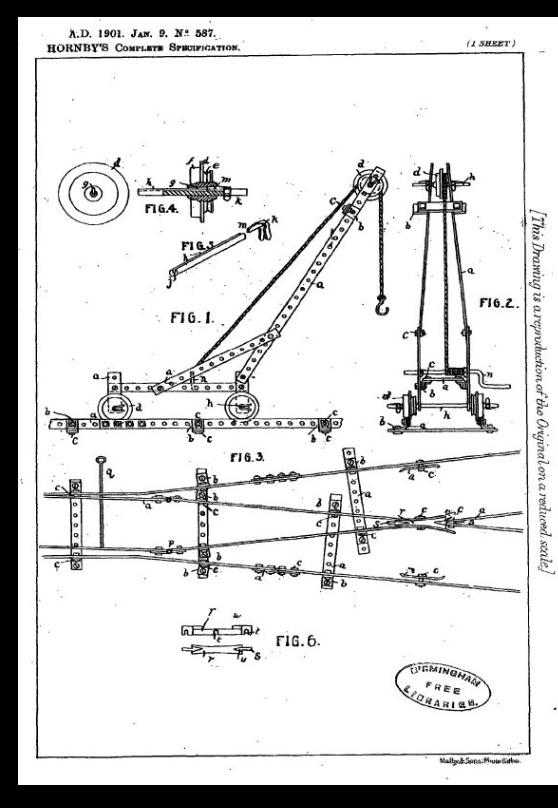
Frank Hornby’s 1901 patent for Mechanics Made Easy, showing the key element of constructional parts with equidistant holes, allowing a variety of models to be made.
ENGINEERING FOR BOYS
The key feature of Mechanics Made Easy was that all its components incorporated equidistant holes so that they could be assembled in any number of ways. The second, equally important point, was that all sets could be upgraded by the addition of the appropriate accessory outfit – just the thing for birthdays or Christmas. In the interim, individual spare parts could be bought from the local agent. These principles were carried through to the growing Meccano system and guaranteed the success of the company.
Mechanics Made Easy was initially marketed as a toy. This is clear from the wording on the tin of some early sets: “A Constructional Mechanical Toy.”
At this stage there is no mention of the toy being specifically for boys although this is certainly implied. One version of the beginner set shows a boy building a model while a younger girl looks on.
The same image appears on the Mechanics Made Easy manual at right.
Significantly, the system is described as an “invention [which has] for its object the training of the young in mechanical construction.”
There are two important points here. Firstly, the ungendered “the young” and secondly, that judging by the age of the children in the photograph, the toy is clearly aimed at children under the age of twelve.
The thrust of Hornby’s marketing began to change after 1907. The Meccano system became more complex, with the addition of a wider range of gears and complex parts better able to reproduce real world mechanical practice. Clockwork and electric motors were also introduced. Before World War I girls sometimes appear in Meccano images although the advertising slant is clearly changing.
Tom Richie has rigorously analysed Meccano’s evolving identity over its hundred-year life. He shows how after 1910 the promotional emphasis shifted to Meccano’s ability to teach scientific and engineering principles. Girls did not appear in Meccano advertising again until 1979. (2) The most common image through to the 1970s would be of two boys working on a large, complex model. Sometimes they would be accompanied by their father and Meccano became “Engineering for Boys”.
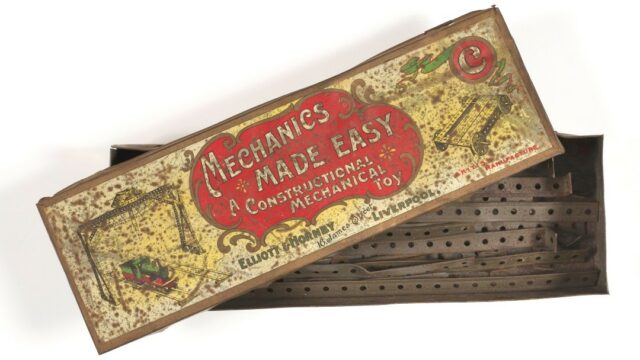
A Mechanics Made Easy set from the Te Manawa collection

THE MECCANO MAGAZINE
During the Great War, much of the Meccano factory’s production was turned over to war work. This did not stop Hornby from starting the Meccano Magazine in 1916, his most successful piece of self-promotion. The “MM”, as it became known to its devotees, is available online, covering the magazine’s complete run from 1916 to 1981. It offers a window into both the development of the Meccano empire and the culture in which it flourished.
Initially the magazine was little more than a four-page vehicle for Hornby’s boosterism. There was a long-running serial on the history of Meccano in which he addresses his readers as “boys” and “you boys”. The music hall celebrity Wee Georgie Wood was conscripted to write a column in praise of Meccano and there were regular model making competitions with hefty prizes. First prize was always “£50 cash” with lesser prizes of Meccano products. There were also essay competitions, many of which encouraged readers to promote their hobby and indulge in homilies worthy of Samuel Smiles.
Max Covill of Weymouth wrote how Meccano had “made a handy boy” of him and that prior to taking up Meccano he “couldn’t tell a nut from a bolt.” (3) D.W. Hall of Newquay suggested that “the only person who hates Meccano must be Satan, for so many hands are busy making toys and models that he cannot find any idle ones.” (4) Louis Cunliffe of Manchester imagined Meccano as an instrument to promote British greatness: “In the future the nation will produce a class of engineers that has never been excelled before, due to the popularity of Meccano amongst the boys of this country.” (5)
This evangelical tone is reflected in the objectives of the Meccano Guild that Hornby founded in 1919. These included fostering “clean-mindedness, truthfulness and ambition” and “to encourage boys in pursuit of their studies and hobbies and especially in the development of their knowledge of mechanical and engineering principles.” (6) Guild members could set up or join a Meccano Club, and these spread throughout Britain and its Empire. New Zealand figures strongly in the club news pages of the MM. In 1927 Auckland’s club based in Wiseman’s store was the largest in the world with over 1000 members. (7)
In 1921 Ellison Hawks became Editor of the Meccano Magazine. Hawks was a writer of popular science books and his approach perfectly suited Frank Hornby’s agenda. The MM grew in size and content throughout the 1920s, becoming a fully-fledged popular science and technology magazine pitched at older boys and their fathers. There were regular sections on Meccano modelling and Hornby model railways – introduced in 1920 – but also stories on subjects such as civil engineering, railway locomotives, aircraft and bridge building. Science and engineering were portrayed as high endeavours, and engineers as role models of enterprise and persistence.
The 1929 issues of MM give a sense of the magazine’s range. There were articles on the history of rubber, the possibility of a Channel tunnel between England and France, the lives of famous inventors, aircraft engines, bell founding, forging a fifty-ton crankshaft for a marine engine and building the Sydney Harbour Bridge. The titles appearing in the monthly book reviews page spell out this heroic message: The Romance of Flight; Engineering Adventure; Wireless – the Modern Magic Carpet; Living Machinery; Wonders of Engineering. As an educational toy, Meccano was ideally placed to prepare boys for this brave new world. “The toy that made engineering great,” ran the slogan of one advertisement.
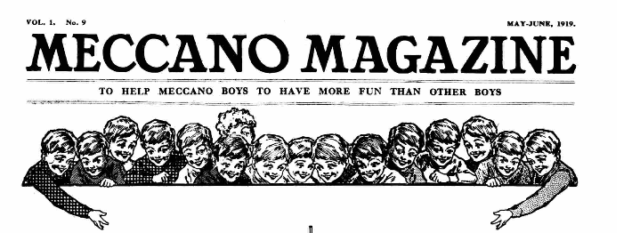
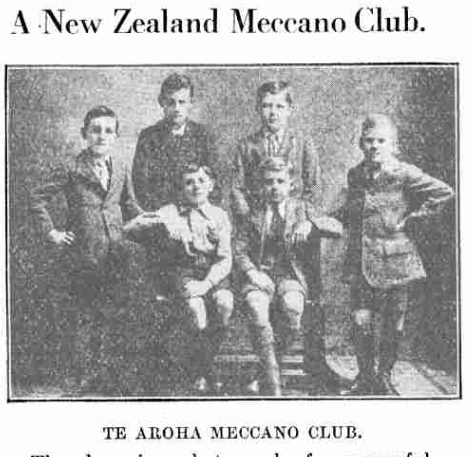
MECCANO – THE KEY TO MANHOOD
This was an unashamedly male world in which Dad was exhorted to buy Meccano for the good of his sons’ education. “Meccano only becomes a toy when it [the completed model] is being played with,” Hornby wrote in a message to fathers in a 1918 issue of MM. The tone of the MM remained aspirational throughout the interwar years, clearly reflecting middle class culture of the time and in particular the role of boys and men. The vocational guidance series ‘What Shall I Be?’, run in the early 1930s, described the work of distinctly middle-class professionals – electrical engineers, accountants, architects and editors. The implication was that Meccano fostered intelligence and scientific literacy so that its adherents could aspire to jobs like these, eventually becoming the pipe smoking fathers of a new generation of Meccano Boys. Alf Wight – better known by his pen-name James Herriot – first considered becoming a vet after reading such an article in the MM. (8)
Frank Hornby was a salesman and hammered the theme of “Engineering for Boys” because it was good for business. Engineering was sexy, progressive and a quintessentially male domain. Not that this stopped girls from commandeering their brothers’ Meccano sets and building models with them. Phyllis Alexander was one of the winners in the 1919 MM essay competition What Meccano has done for me.
“Most people consider Meccano first and foremost for boys,” she wrote, “so perhaps it might interest you to hear how I, a girl, spent so many happy hours ‘messing about’, as my brothers called it, with their Meccano outfit.” (9) Making models, she discovered, was “rare fun.” New Zealand girls were no different. When I took a Meccano model to school for a hobbies day in the early nineteen sixties at least two girls told me that they played with their brothers’ Meccano sets. One asked me if I had any bevel gears (I didn’t). New Zealand racing driver and top Jaguar mechanic Sybil Lupp (1916-1994) “[spurned] dolls to build model railways and play with Meccano.”

A Meccano manual cover from 1950 in which Meccano has become a symbol of a cosy middle class life. The block setting crane is loosely based on a pre-war model plan and became an icon remembered by all Meccano old boys
MECCANO – No. 8 WIRE FOR BOYS?
Meccano’s popularity in New Zealand isn’t surprising, given our national mythology of No. 8 wire adaptability. Meccano modelling requires a flexible approach in which standard parts are used for different purposes. There were Meccano Clubs in most of our major cities and Meccano was as familiar an icon in Aotearoa as it was in the UK.
As an amateur trader in antiques during the 1990s I often came across accumulations of Meccano spanning three generations, particularly in the homes of farming families. These would include early nickel-plated parts, the later blue and gold pieces from the 1930s and red and green components from the post-war period. Grandfather’s set had been passed to his son who added to it before it came down to the vendor, a middle aged man whose own children preferred Lego. Imported toys were hard to come by in 1950s New Zealand, so boys often fashioned their own Meccano-compatible parts from whatever was to hand. A Turakina farmer in his sixties showed me plates made from high grade aluminium which he’d cut from the bodywork of an abandoned car in his father’s implement shed when he was a boy. Thirty years later the car was identified as a veteran Mercedes Benz.
Frank Hornby died a millionaire in 1936, the most successful toy manufacturer in England. In 1920 he had began manufacturing model railway sets and launched the Dinky Toy range of model vehicles in 1934. Between 1931 and 1935 he was Conservative MP for Everton. Although his empire reached its apogee before the war, decline took another two decades to set in, which I will discuss in the next entry in this series.

Engineering as high endeavour. An imagined floating airfield to assist transatlantic flight. Pre-war MM covers were dramatic artworks in which engineering subjects were presented in a dynamic manner
BIBLIOGRAPHY
Bowler, Peter J., Meccano Magazine; Boys’ toys and the popularization of science in early twentieth-century Britain; British Journal for the History of Science, Vol 3 2018 pp. 129 – 146
Veart, David; Hello Boys and Girls; A New Zealand Toy Story; AUP, 2014
Meccano Magazine online, 1916 – 198
Graebe, Chris and Julie; The Hornby Gauge O System; New Cavendish, 1984
Wright, Geoff; The Meccano Super Models; New Cavendish, 1978
Lewis-Stempel, John; Young Herriot; The Early Life and Times of James Herriot; BBC, 2011
Brown, Kenneth D.; Factory of Dreams; A History of Meccano Ltd, 1901 – 1979; Crucible Books, 2007
Ritchie, Thomas. Object Identity: Deconstructing the ‘Hartree Differential Analyser’ and reconstructing a Meccano Analogue Computer; PhD thesis, University of Kent, 2019
Wainman, Ruth; Engineering for Boys: Meccano and the Shaping of a Technical Vision of Boyhood in Twentieth-Century Britain; The Journal of the Social History Society, Vol. 14 (3), (2017), pp. 381-396
Makers of 19th Century Culture, 1800 – 1914 ed. Justin Wintle, RKP, 1982
FOOTNOTES
1 Meccano Magazine, Jan 1932 p. 6
2 Ritchie, p. 69
3 MM May 1919
4 MM, March 1917
5 MM March 1917
6 MM September 1919
7 Veart, p. 72
8 Lewis-Stempel, pp. 71-72
9 MM May 1919

